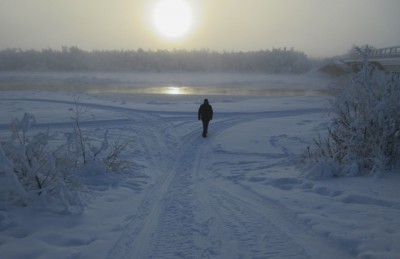A low mist hung over Kiruna as we drove out of town along the Kalix river. We were hoping to break into the bright sunshine ahead – there was a feeling of spring, even though it was minus 30 degrees. Sunlight in February can be fierce in a white landscape and it draws you to it after so long an absence.
We went to a favourite spot, a place on the river where it narrows so much there’s always a stream of open water. People came here in the 1800s to live off the river fish, and this close knit community survives, since most people in the village have the same name, Fjällborg. We like to walk along the river, enjoying the contrast between the thick ice on the river edges and the trickling and splashing water in the middle, shaking particles of ice as it pushes by.

It’s rare to find moving water in winter so it’s a popular place – at least with us and with birds overwintering in the Arctic. Small birds skim the water surface and you wonder how they survive these conditions. Where the water is moving the air above looks like a steam bath, the condensing humidity marking the area of ice that it is unsafe for us to walk on.
We met a man as we walked back to the car. He lives in the village, and he’s the one who drives his snowscooter in strange loops on the ice to keep paths open for bird watchers who come here. He described the birds he sees, such as the white-throated dipper, and pairs of swans that stay here all year round. Then he told us his name. Fjällborg, of course.
Driving into town we drove back into a dense mist. When we reached the main road we wondered if the water leak earlier in the day had been the cause. A mains pipe had burst near the road spewing water across it. A humid mist would have formed above the area, and the water quickly turn to ice. We don’t normally have a problem with ice in Kiruna (because the snow doesn’t melt) but a burst water pipe – open water in the street – is an instant ice rink. It caused a bit of chaos earlier in the day, a car skidding on an unexpected patch of ice, but by the time we were there it had been cleared. An area of frozen mud was visible along the road, and machines were at work heating up the ground and mending the pipes. A thick white mist still hung in the air all around, trapped by cold temperatures above.
Out at the airport an army of Volvo engineers and mechanics were testing new trucks in winter conditions. We only knew this because someone working there was staying with us. They were testing the engines, the brakes, the connections, the power supply, the living conditions in the cabs. Kiruna provides most of the tough challenges of winter, but the one thing missing is ice. They were able create it though, by releasing water onto the runway.
It was a watery, misty, icy kind of day in Kiruna.


